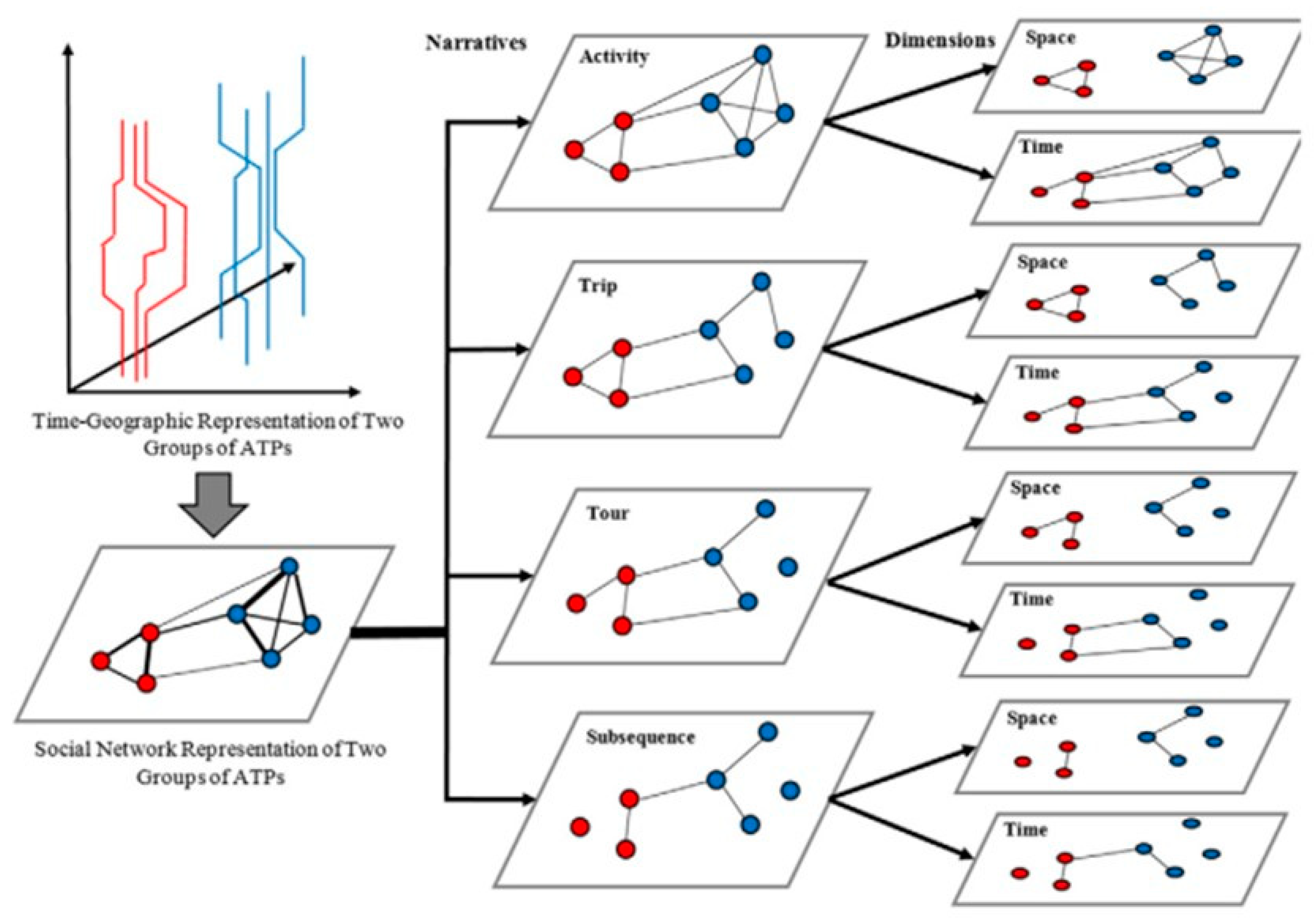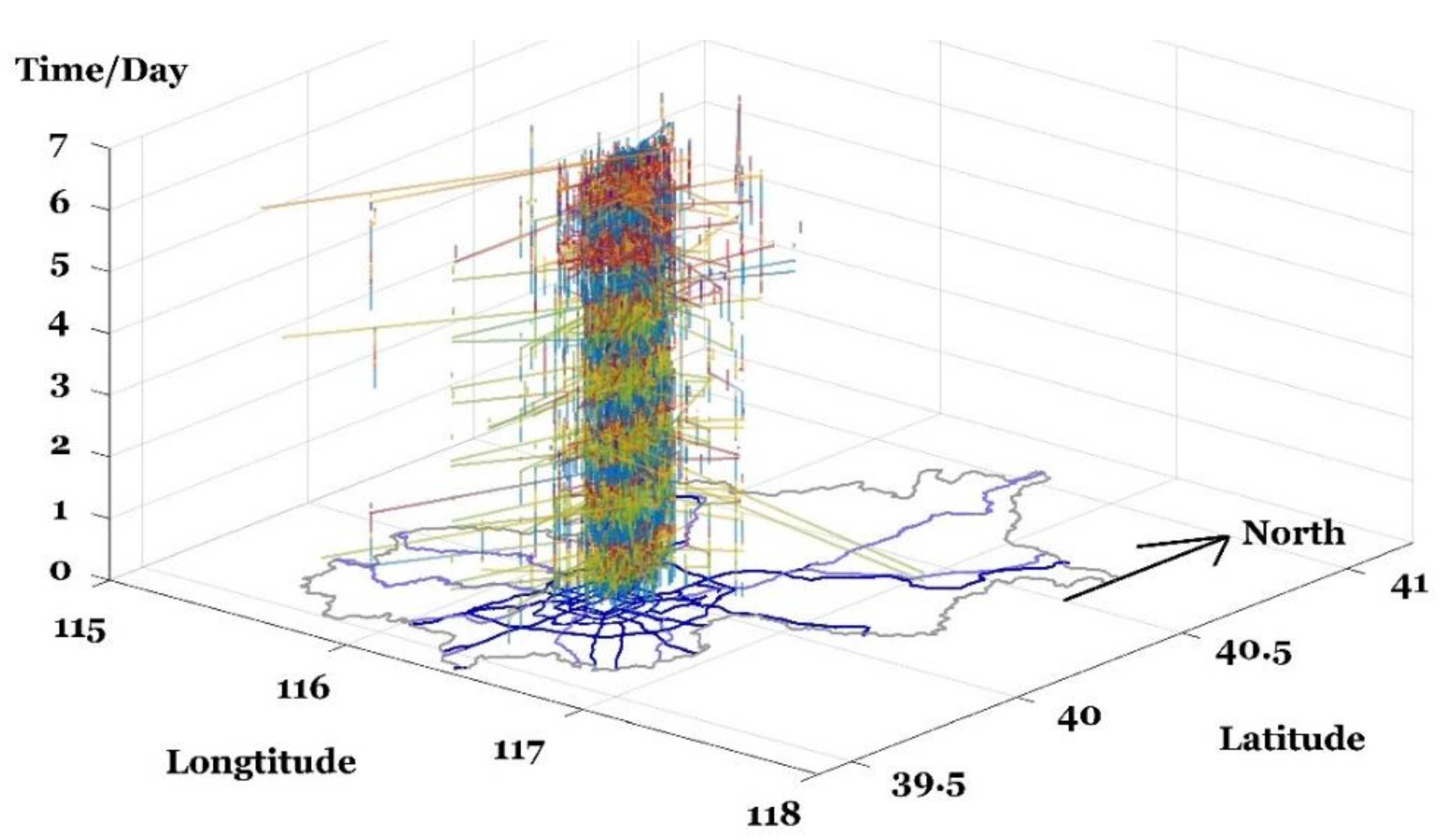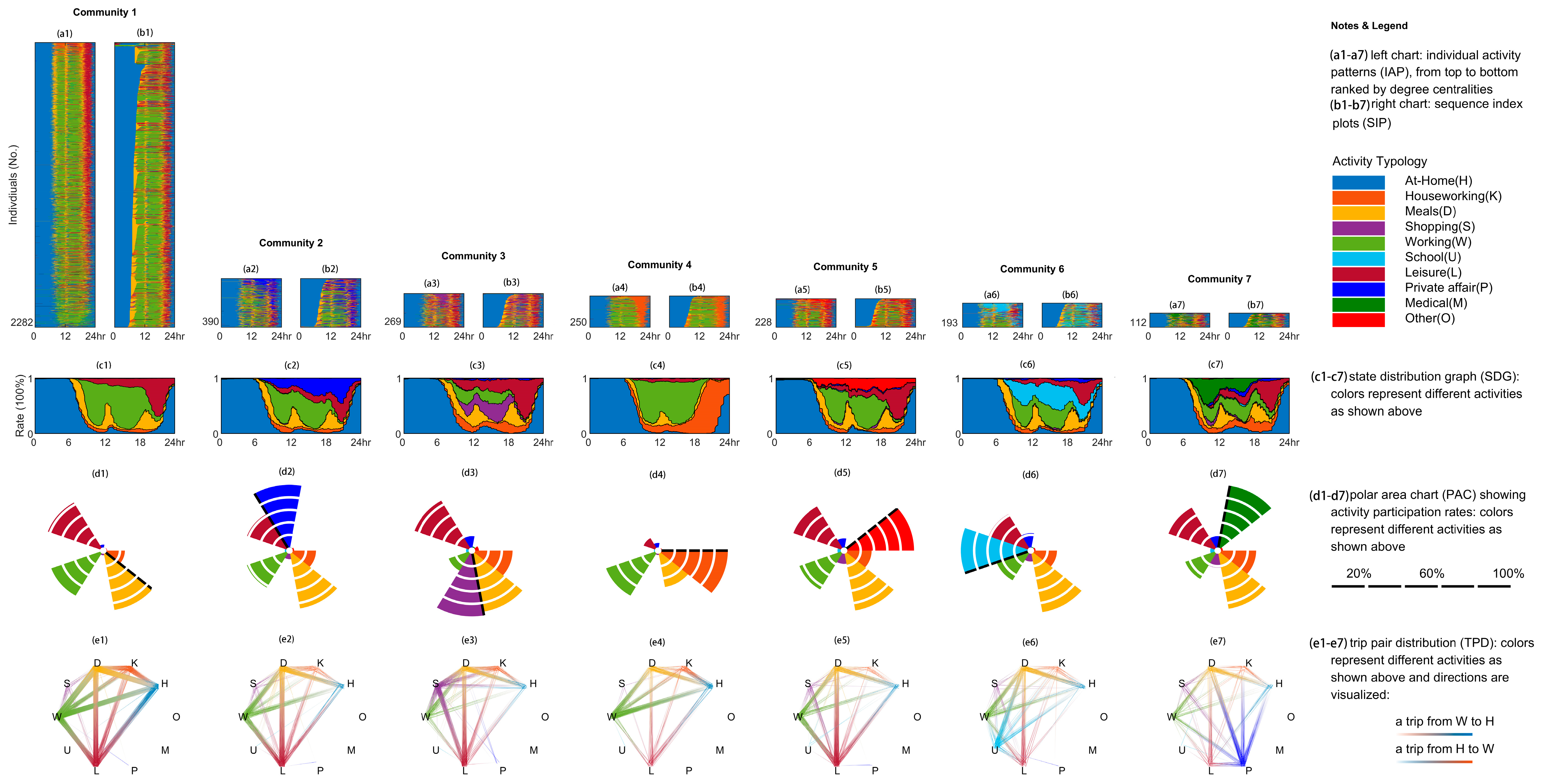Interpersonal and Intrapersonal Variabilities in Daily Activity-Travel Patterns: A Networked Spatiotemporal Analysis
Abstract
:1. Introduction
2. Literature Review
2.1. Activity-Travel Pattern Mining
2.2. Interpersonal and Intrapersonal Variabilities
3. Method
3.1. A Network Analysis Approach
3.2. Multilevel Multinomial Logit Model
4. A Case Study in Beijing, China
4.1. Data and Variables
4.2. Analytical Results
4.2.1. Activity-Travel Patterns and Their Variabilities across Days in a Week
4.2.2. Testing Intrapersonal and Interpersonal Variabilities of Activity-Travel Patterns Using a Multilevel Model
5. Discussion and Conclusions
Author Contributions
Funding
Institutional Review Board Statement
Informed Consent Statement
Data Availability Statement
Acknowledgments
Conflicts of Interest
References
- Pendyala, R.M.; Yamamoto, T.; Kitamura, R. On the Formulation of Time-Space Prisms to Model Constraints on Personal Activity-Travel Engagement. Transportation 2002, 29, 73–94. [Google Scholar] [CrossRef]
- Raux, C.; Ma, T.-Y.; Cornelis, E. Variability in Daily Activity-Travel Patterns: The Case of a One-Week Travel Diary. Eur. Transp. Res. Rev. 2016, 8, 26. [Google Scholar] [CrossRef]
- Elias, W.; Shiftan, Y. Ethnic Groups Differences in Regard to Social Networks, Daily Activity Patterns, and Driving Behavior. Transp. Res. Part F Traffic Psychol. Behav. 2017, 46, 316–328. [Google Scholar] [CrossRef]
- Lee, J.H.; Davis, A.; Yoon, S.Y.; Goulias, K.G. Exploring Daily Rhythms of Interpersonal Contacts: Time-of-Day Dynamics of Human Interactions with Latent Class Cluster Analysis. Transp. Res. Rec. 2017, 2666, 58–68. [Google Scholar] [CrossRef]
- Dharmowijoyo, D.B.E.; Susilo, Y.O.; Karlström, A. Analysing the Complexity of Day-to-Day Individual Activity-Travel Patterns Using a Multidimensional Sequence Alignment Model: A Case Study in the Bandung Metropolitan Area, Indonesia. J. Transp. Geogr. 2017, 64, 1–12. [Google Scholar] [CrossRef]
- Egu, O.; Bonnel, P. Investigating Day-to-Day Variability of Transit Usage on a Multimonth Scale with Smart Card Data. A Case Study in Lyon. Travel Behav. Soc. 2020, 19, 112–123. [Google Scholar] [CrossRef]
- Hanson, S.; Huff, J.O. Assessing Day-to-Day Variability in Complex Travel Patterns; Transportation Research Board: Washington, DC, USA, 1982. [Google Scholar]
- Pas, E.I. Intrapersonal Variability and Model Goodness-of-Fit. Transp. Res. Part A Gen. 1987, 21, 431–438. [Google Scholar] [CrossRef]
- Schönfelder, S. Urban Rhythms—Modelling the Rhythms of Individual Travel Behaviour. Ph.D. Thesis, Swiss Federal Institute of Technology Zurich, Zurich, Switzerland, 2006; p. 274. [Google Scholar] [CrossRef]
- Zhang, A.; Kang, J.E.; Axhausen, K.; Kwon, C. Multi-Day Activity-Travel Pattern Sampling Based on Single-Day Data. Transp. Res. Part C Emerg. Technol. 2018, 89, 96–112. [Google Scholar] [CrossRef]
- Pas, E.I.; Sundar, S. Intrapersonal Variability in Daily Urban Travel Behavior: Some Additional Evidence. Transportation 1995, 22, 135–150. [Google Scholar] [CrossRef]
- Kwan, M.-P. Gender and Individual Access to Urban Opportunities: A Study Using Space—Time Measures. Prof. Geogr. 1999, 51, 211–227. [Google Scholar] [CrossRef]
- Kwan, M.-P. Space-Time and Integral Measures of Individual Accessibility: A Comparative Analysis Using a Point-Based Framework. Geogr. Anal. 2010, 30, 191–216. [Google Scholar] [CrossRef]
- Buliung, R.N.; Roorda, M.J.; Remmel, T.K. Exploring Spatial Variety in Patterns of Activity-Travel Behaviour: Initial Results from the Toronto Travel-Activity Panel Survey (TTAPS). Transportation. 2008, 35, 697–722. [Google Scholar] [CrossRef]
- Heinen, E.; Chatterjee, K. The Same Mode Again? An Exploration of Mode Choice Variability in Great Britain Using the National Travel Survey. Transp. Res. Part A Policy Pract. 2015, 78, 266–282. [Google Scholar] [CrossRef] [Green Version]
- Huff, J.O.; Hanson, S. Repetition and Variability in Urban Travel. Geogr. Anal. 2010, 18, 97–114. [Google Scholar] [CrossRef]
- Huff, J.O.; Hanson, S. Measurement of habitual behaviour: Examining systematic variability in repetitive travel. In Developments in Dynamic and Activity-Based Approaches to Travel Analysis; Oxford Studies in Transport; Jones, P., Ed.; Avebury: Aldershot, UK, 1990; pp. 229–249. ISBN 978-0-566-07023-5. [Google Scholar]
- Neutens, T.; Delafontaine, M.; Scott, D.M.; De Maeyer, P. An Analysis of Day-to-Day Variations in Individual Space—Time Accessibility. J. Transp. Geogr. 2012, 23, 81–91. [Google Scholar] [CrossRef] [Green Version]
- Kitamura, R.; van der Hoorn, T. Regularity and Irreversibility of Weekly Travel Behavior. Transportation 1987, 14, 227–251. [Google Scholar] [CrossRef]
- Jones, P.; Clarke, M. The Significance and Measurement of Variability in Travel Behaviour. Transportation 1988, 15. [Google Scholar] [CrossRef]
- Harvey, A.S.; Taylor, M.E.; Ellis, S.; Aas, D. 24 Hour Society and Passenger Travel; Saint Mary’s University: Halifax, NS, Canada, 1997. [Google Scholar]
- Goulet-Langlois, G.; Koutsopoulos, H.N.; Zhao, Z.; Zhao, J. Measuring Regularity of Individual Travel Patterns. IEEE Trans. Intell. Transport. Syst. 2018, 19, 1583–1592. [Google Scholar] [CrossRef] [Green Version]
- Bricka, S.G.; Richard, T.B.; Christopher, L.S.; Nicholas, W. Origin-Destination data collection technology. In Mobile Technologies for Activity—Travel Data Collection and Analysis; IGI Global: Hershey, PA, USA, 2014; pp. 1–16. ISBN 9781466661714. [Google Scholar]
- Egu, O.; Bonnel, P. How Comparable Are Origin-Destination Matrices Estimated from Automatic Fare Collection, Origin-Destination Surveys and Household Travel Survey? An Empirical Investigation in Lyon. Transp. Res. Part A Policy Pract. 2020, 138, 267–282. [Google Scholar] [CrossRef]
- Zhang, W.; Thill, J.-C. Detecting and Visualizing Cohesive Activity-Travel Patterns: A Network Analysis Approach. Comput. Environ. Urban Syst. 2017, 66, 117–129. [Google Scholar] [CrossRef]
- Cho, S.; Janssens, D.; Joh, C.; Kim, H.; Choi, K.; Park, D. Space—Time Sequential Similarity for Identifying Factors of Activity-Travel Pattern Segmentation: A Measure of Sequence Alignment and Path Similarity. Geogr. Anal. 2019, 51, 203–220. [Google Scholar] [CrossRef]
- Flyvbjerg, B.; Holm, M.S.; Buhl, S.L. How (In)Accurate Are Demand Forecasts in Public Works Projects? The Case of Transportation. arXiv 2013, arXiv:1303.6654. [Google Scholar] [CrossRef] [Green Version]
- Kwan, M.-P. Interactive Geovisualization of Activity-Travel Patterns Using Three-Dimensional Geographical Information Systems: A Methodological Exploration with a Large Data Set. Transp. Res. Part C Emerg. Technol. 2000, 8, 185–203. [Google Scholar] [CrossRef]
- Joh, C.-H.; Arentze, T.; Hofman, F.; Timmermans, H. Activity Pattern Similarity: A Multidimensional Sequence Alignment Method. Transp. Res. Part B Methodol. 2002, 36, 385–403. [Google Scholar] [CrossRef]
- Shaw, S.-L.; Yu, H.; Bombom, L.S. A Space-Time GIS Approach to Exploring Large Individual-Based Spatiotemporal Datasets. Trans. GIS. 2008, 12, 425–441. [Google Scholar] [CrossRef]
- Guo, D. Flow Mapping and Multivariate Visualization of Large Spatial Interaction Data. IEEE Trans. Visual. Comput. Graph. 2009, 15, 1041–1048. [Google Scholar] [CrossRef]
- Giannotti, F.; Nanni, M.; Pinelli, F.; Pedreschi, D. Trajectory Pattern Mining. In Proceedings of the 13th ACM SIGKDD International Conference on Knowledge Discovery and Data Mining—KDD’07, San Jose, CA, USA, 12–15 August 2007; ACM Press: New York, NY, USA, 2007; p. 330. [Google Scholar] [CrossRef] [Green Version]
- Lee, J.-G.; Han, J.; Whang, K.-Y. Trajectory Clustering: A Partition-and-Group Framework. In Proceedings of the 2007 ACM SIGMOD International Conference on Management of Data—SIGMOD’07, Beijing, China, 11–14 June 2007; ACM Press: New York, NY, USA, 2007; p. 593. [Google Scholar] [CrossRef]
- Guo, D.; Liu, S.; Jin, H. A Graph-Based Approach to Vehicle Trajectory Analysis. J. Locat. Based Serv. 2010, 4, 183–199. [Google Scholar] [CrossRef]
- Thériault, M.; Claramunt, C.; Villeneuve, P.Y. A Spatio-Temporal Taxonomy for the Representation of Spatial Set Behaviours. In Spatio-Temporal Database Management; Lecture Notes in Computer Science; Böhlen, M.H., Jensen, C.S., Scholl, M.O., Eds.; Springer: Berlin/Heidelberg, Germany, 1999; Volume 1678, pp. 1–18. ISBN 978-3-540-66401-7. [Google Scholar]
- Buliung, R.N.; Kanaroglou, P.S. A GIS Toolkit for Exploring Geographies of Household Activity/Travel Behavior. J. Transp. Geogr. 2006, 14, 35–51. [Google Scholar] [CrossRef]
- Patterson, Z.; Farber, S. Potential Path Areas and Activity Spaces in Application: A Review. Transp. Rev. 2015, 35, 679–700. [Google Scholar] [CrossRef]
- Jiang, S.; Ferreira, J.; González, M.C. Clustering Daily Patterns of Human Activities in the City. Data Min. Knowl. Disc. 2012, 25, 478–510. [Google Scholar] [CrossRef] [Green Version]
- Kwan, M.-P.; Xiao, N.; Ding, G. Assessing Activity Pattern Similarity with Multidimensional Sequence Alignment Based on a Multiobjective Optimization Evolutionary Algorithm: Assessing Activity Pattern Similarity. Geogr. Anal. 2014, 46, 297–320. [Google Scholar] [CrossRef] [PubMed] [Green Version]
- Joh, C.-H.; Polak, J.W.; Ruiz, T. Characterizing Global Activity Schedule Adjustment Behavior by Using a Sequence Alignment Method. Transp. Res. Rec. 2005, 1926, 26–32. [Google Scholar] [CrossRef]
- Shoval, N.; Isaacson, M. Sequence Alignment as a Method for Human Activity Analysis in Space and Time. Ann. Assoc. Am. Geogr. 2007, 97, 282–297. [Google Scholar] [CrossRef]
- Abdel-Aty, M.A.; Kitamura, R. Exploring Route Choice Behavior Using Geographic Information System-Based Alternative Routes and Hypothetical Travel Time Information Input. In Transportation Research Record 7; Transportation Research Board: Washington, DC, USA, 1995. [Google Scholar]
- Larsen, K.; Gilliland, J.; Hess, P.; Tucker, P.; Irwin, J.; He, M. The Influence of the Physical Environment and Sociodemographic Characteristics on Children’s Mode of Travel to and From School. Am. J. Public Health 2009, 99, 520–526. [Google Scholar] [CrossRef] [PubMed]
- Yang, M.; Wang, W.; Chen, X.; Wang, W.; Xu, R.; Gu, T. Modeling Destination Choice Behavior Incorporating Spatial Factors, Individual Sociodemographics, and Travel Mode. J. Transp. Eng. 2010, 136, 800–810. [Google Scholar] [CrossRef]
- Moudon, A.V.; Huang, R.; Stewart, O.T.; Cohen-Cline, H.; Noonan, C.; Hurvitz, P.M.; Duncan, G.E. Probabilistic Walking Models Using Built Environment and Sociodemographic Predictors. Popul. Health Metr. 2019, 17, 7. [Google Scholar] [CrossRef]
- Jahre, A.B.; Bere, E.; Nordengen, S.; Solbraa, A.; Andersen, L.B.; Riiser, A.; Bjørnarå, H.B. Public Employees in South-Western Norway Using an e-Bike or a Regular Bike for Commuting—A Cross-Sectional Comparison on Sociodemographic Factors, Commuting Frequency and Commuting Distance. Prev. Med. Rep. 2019, 14, 100881. [Google Scholar] [CrossRef] [PubMed]
- Fan, J.X.; Wen, M.; Kowaleski-Jones, L. Sociodemographic and Environmental Correlates of Active Commuting in Rural America: Active Commuting in Rural America. J. Rural Health 2015, 31, 176–185. [Google Scholar] [CrossRef]
- Xianyu, J.; Rasouli, S.; Timmermans, H. Analysis of Variability in Multi-Day GPS Imputed Activity-Travel Diaries Using Multi-Dimensional Sequence Alignment and Panel Effects Regression Models. Transportation 2017, 44, 533–553. [Google Scholar] [CrossRef]
- Berg, J.K.; Aber, J.L. A Multilevel View of Predictors of Children’s Perceptions of School Interpersonal Climate. J. Educ. Psychol. 2015, 107, 1150–1170. [Google Scholar] [CrossRef] [Green Version]
- Kitamura, R.; Yamamoto, T.; Susilo, Y.O.; Axhausen, K.W. How Routine Is a Routine? An Analysis of the Day-to-Day Variability in Prism Vertex Location. Transp. Res. Part A Policy Pract. 2006, 40, 259–279. [Google Scholar] [CrossRef] [Green Version]
- Hatcher, S.G.; Mahmassani, H. Daily Variability of Route and Trip Scheduling Decisions for the Evening Commute. In Transportation Research Record 11; Transportation Research Board: Washington, DC, USA, 1992. [Google Scholar]
- Chikaraishi, M.; Fujiwara, A.; Zhang, J.; Axhausen, K.W. Exploring Variation Properties of Departure Time Choice Behavior by Using Multilevel Analysis Approach. Transp. Res. Rec. 2009, 2134, 10–20. [Google Scholar] [CrossRef] [Green Version]
- Susilo, Y.O.; Axhausen, K.W. Stability in Individual Daily Activity-Travel-Location Patterns: A Study Using the Herfindahl-Hirschman Index; ETH Zurich: Zurich, Switzerland, 2007. [Google Scholar]
- Blondel, V.D.; Guillaume, J.-L.; Lambiotte, R.; Lefebvre, E. Fast Unfolding of Communities in Large Networks. J. Stat. Mech. 2008, 2008, P10008. [Google Scholar] [CrossRef] [Green Version]
- Fortunato, S. Community Detection in Graphs. Phys. Rep. 2010, 486, 75–174. [Google Scholar] [CrossRef] [Green Version]
- Zhou, L.; Zhang, W.; Fang, C.; Sun, H.; Lin, J. Actors and Network in the Marketization of Rural Collectively-Owned Commercial Construction Land (RCOCCL) in China: A Pilot Case of Langfa, Beijing. Land Use Policy. 2020, 99, 104990. [Google Scholar] [CrossRef]
- Zhang, W.; Thill, J.-C. Mesoscale Structures in World City Networks. Annals of the American Association of Geographers. 2019, 109, 887–908. [Google Scholar] [CrossRef]
- Zhang, W.; Fang, C.; Zhou, L.; Zhu, J. Measuring Megaregional Structure in the Pearl River Delta by Mobile Phone Signaling Data: A Complex Network Approach. Cities 2020, 104, 102809. [Google Scholar] [CrossRef]
- Zhang, W.; Zhang, M. Incorporating Land Use and Pricing Policies for Reducing Car Dependence: Analytical Framework and Empirical Evidence. Urban Stud. 2018, 55, 3012–3033. [Google Scholar] [CrossRef]
- Zhang, M.; Zhang, W. When Context Meets Self-Selection: The Built Environment–Travel Connection Revisited. J. Plan. Educ. Res. 2020, 40, 304–319. [Google Scholar] [CrossRef]
- Newman, M.E.J. Modularity and Community Structure in Networks. Proc. Natl. Acad. Sci. USA 2006, 103, 8577–8582. [Google Scholar] [CrossRef] [PubMed] [Green Version]



| Variables | Description | Mean | Std. |
|---|---|---|---|
| Dependent variable | |||
| The class of detected communities 1 | Each type of community has a group of individuals with a similar activity-travel pattern (A multiple categorial variable: Type-1, 2, … 7 Communities or Patterns). | 4 | 2.16 |
| Independent variables | |||
| 1.Intrapersonal Attributes: Day variables (Level 1) | |||
| Monday | 1: Monday, 0: others | 0.15 | 0.36 |
| Tuesday | 1: Tuesday, 0: others | 0.15 | 0.36 |
| Wednesday | 1: Wednesday, 0: others | 0.15 | 0.36 |
| Thursday | 1: Thursday, 0: others | 0.15 | 0.36 |
| Friday | 1: Friday, 0: others | 0.15 | 0.36 |
| Saturday | 1: Saturday, 0: others | 0.13 | 0.33 |
| Sunday | 1: Sunday, 0: others | 0.12 | 0.32 |
| 2.Interpersonal Attributes: Individual’s socioeconomic features (Level 2) | |||
| Gender | 1: Male, 0: female | 0.46 | 0.50 |
| Age under 30 | 1: age < 30 years old; 0: others | 0.34 | 0.48 |
| Age between 30 and 40 | 1: 30 age < 40 years old; 0: others | 0.39 | 0.49 |
| Age between 40 and 50 | 1: 40 age <50 years old; 0: others | 0.18 | 0.38 |
| Age over 50 | 1: age 50 years old; 0: others | 0.08 | 0.28 |
| Hukou 2 | 1: with Beijing’s hukou 2, 0: others | 0.70 | 0.46 |
| Education low level | 1: Uneducated, primary and middle school; 0: others | 0.15 | 0.35 |
| Education medium level | 1: College or undergraduate; 0: others | 0.71 | 0.46 |
| Education high level | 1: Postgraduate and above; 0: others | 0.15 | 0.36 |
| Employment status | 1: Employed, 0: Unemployed | 0.90 | 0.30 |
| Income low level | 1: Less than 2000 yuan per month, 0: others | 0.15 | 0.36 |
| Income medium level | 1: 2001–6000 yuan per month, 0: others | 0.63 | 0.48 |
| Income high level | 1: above 6000 yuan per month, 0: others | 0.22 | 0.42 |
| Marriage status | 1: unmarried, 0: married | 0.24 | 0.43 |
| Day | Working Pattern | Private-Affair Pattern | Leisure Pattern | Working-Housework Pattern | Other-Activities Pattern | School-Related Pattern | Medical-Activity Pattern |
|---|---|---|---|---|---|---|---|
| Monday | 65.71% | 10.77% | 3.23% | 7.36% | 5.75% | 3.95% | 3.23% |
| Tuesday | 64.95% | 10.68% | 2.85% | 7.83% | 6.76% | 4.98% | 1.96% |
| Wednesday | 65.61% | 10.35% | 3.51% | 6.84% | 6.31% | 4.04% | 3.33% |
| Thursday | 66.49% | 8.83% | 4.68% | 6.85% | 5.59% | 5.23% | 2.34% |
| Friday | 64.40% | 9.95% | 4.89% | 7.33% | 5.58% | 4.01% | 3.84% |
| Saturday | 49.79% | 11.86% | 17.16% | 5.93% | 4.87% | 7.84% | 2.54% |
| Sunday | 46.90% | 11.26% | 18.39% | 4.14% | 8.28% | 7.13% | 3.91% |
| Variables | Private-Affair Pattern | Leisure Pattern | Working-Housework Pattern | Other-Activities Pattern | School-Related Pattern | Medical-Activity Pattern |
|---|---|---|---|---|---|---|
| Intrapersonal Attributes: Day variable | ||||||
| Tuesday | ||||||
| Wednesday | ||||||
| Thursday | ||||||
| Friday | ||||||
| Saturday | 0.70 ** | 2.27 *** | 1.19 *** | |||
| Sunday | 0.73 ** | 2.41 *** | 1.00 *** | 1.23 *** | 0.84 ** | |
| Interpersonal Attributes: Individual’s socioeconomic features | ||||||
| Male | −0.52 ** | −1.00 *** | −0.52 ** | −0.44 ** | −0.61 ** | |
| Age between 30 and 40 | 0.85 ** | 0.70 ** | ||||
| Age between 40 and 50 | −0.94 ** | 0.80 ** | 0.75 ** | |||
| Age over 50 | 1.03 ** | 0.87 * | ||||
| Hukou | 0.94 ** | |||||
| Education low level | −0.67 * | −1.47 ** | ||||
| Education medium level | −0.60 ** | −0.59 * | ||||
| Employed | −0.76 ** | −1.43 *** | −0.92 ** | |||
| Income low level | −0.76 ** | −0.74 ** | ||||
| Income medium level | ||||||
| Unmarried | −1.70 *** | −0.80 ** | −0.90 ** | −0.99 ** | ||
| Constant | −1.12 * | −1.10 ** | −3.10** | −2.59** | −2.35 ** | |
| Log likelihood: −4493.67 | ||||||
| Chi-square: 561.93 *** | ||||||
Publisher’s Note: MDPI stays neutral with regard to jurisdictional claims in published maps and institutional affiliations. |
© 2021 by the authors. Licensee MDPI, Basel, Switzerland. This article is an open access article distributed under the terms and conditions of the Creative Commons Attribution (CC BY) license (http://creativecommons.org/licenses/by/4.0/).
Share and Cite
Zhang, W.; Ji, C.; Yu, H.; Zhao, Y.; Chai, Y. Interpersonal and Intrapersonal Variabilities in Daily Activity-Travel Patterns: A Networked Spatiotemporal Analysis. ISPRS Int. J. Geo-Inf. 2021, 10, 148. https://0-doi-org.brum.beds.ac.uk/10.3390/ijgi10030148
Zhang W, Ji C, Yu H, Zhao Y, Chai Y. Interpersonal and Intrapersonal Variabilities in Daily Activity-Travel Patterns: A Networked Spatiotemporal Analysis. ISPRS International Journal of Geo-Information. 2021; 10(3):148. https://0-doi-org.brum.beds.ac.uk/10.3390/ijgi10030148
Chicago/Turabian StyleZhang, Wenjia, Chunhan Ji, Hao Yu, Yi Zhao, and Yanwei Chai. 2021. "Interpersonal and Intrapersonal Variabilities in Daily Activity-Travel Patterns: A Networked Spatiotemporal Analysis" ISPRS International Journal of Geo-Information 10, no. 3: 148. https://0-doi-org.brum.beds.ac.uk/10.3390/ijgi10030148







